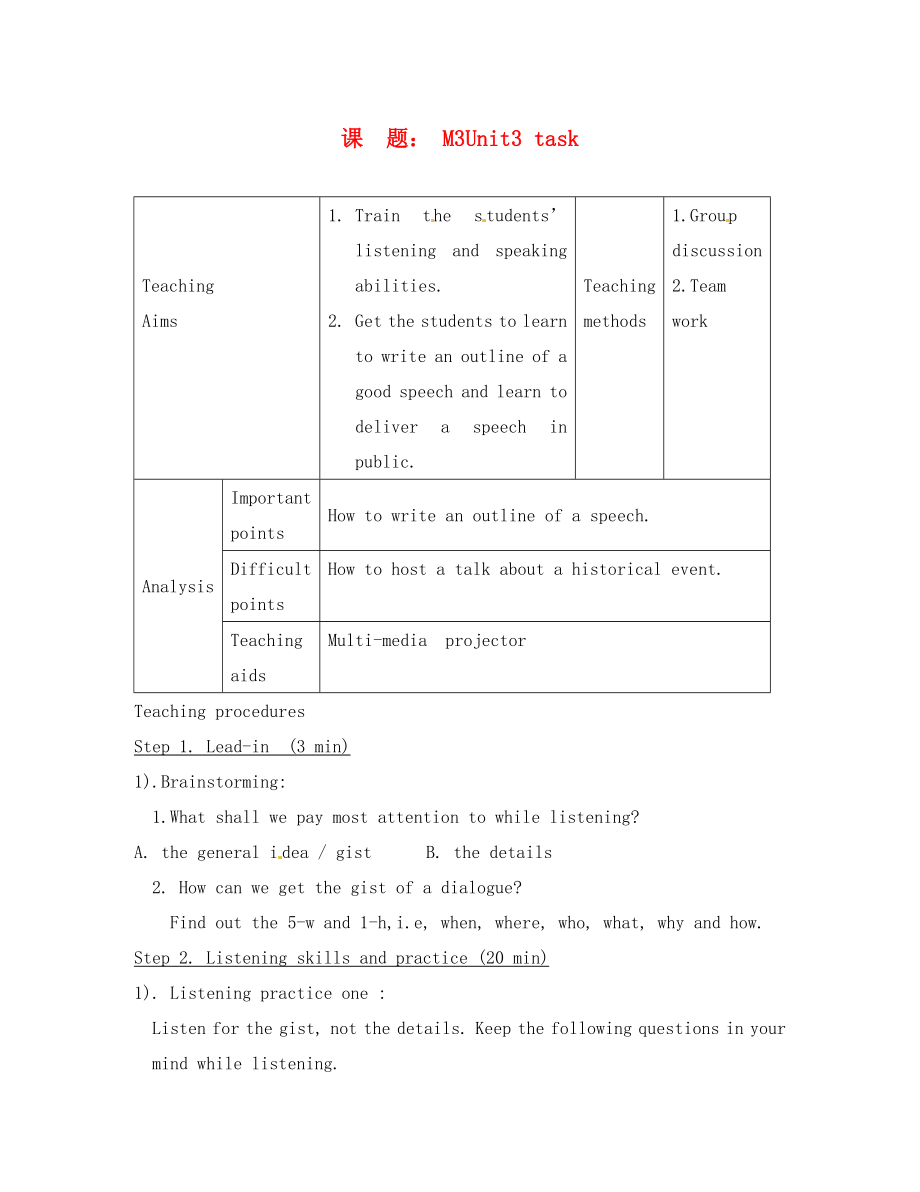《江蘇省江陰市成化高級(jí)中學(xué)高中英語(yǔ) Unit3 task教案 牛津譯林版必修3》由會(huì)員分享�,可在線閱讀,更多相關(guān)《江蘇省江陰市成化高級(jí)中學(xué)高中英語(yǔ) Unit3 task教案 牛津譯林版必修3(4頁(yè)珍藏版)》請(qǐng)?jiān)谘b配圖網(wǎng)上搜索���。
1���、課 題: M3Unit3 task
Teaching
Aims
1. Train the students’ listening and speaking abilities.
2. Get the students to learn to write an outline of a good speech and learn to deliver a speech in public.
Teaching
methods
1.Group discussion
2.Team work
Analysis
Important
points
How to w
2、rite an outline of a speech.
Difficult
points
How to host a talk about a historical event.
Teaching aids
Multi-media projector
Teaching procedures
Step 1. Lead-in (3 min)
1).Brainstorming:
1.What shall we pay most attention to while listening?
A. the general idea / gist B. the detai
3��、ls
2. How can we get the gist of a dialogue?
Find out the 5-w and 1-h,i.e, when, where, who, what, why and how.
Step 2. Listening skills and practice (20 min)
1). Listening practice one :
Listen for the gist, not the details. Keep the following questions in your mind while listening.
2 how man
4�、y people are talking
2 where they are
2 what they are doing
2 what they are talking about
2). Listening practice two.
1. First listening
Have students to listen to Part A and complete the notes on P52. Remind students to focus only on the gist. Check the answers.
2. Second listening
1. Have
5、students to listen to Part B and fill in the blanks as many as possible.
2. Play the tape a second time and stop after each answer or sentence.
3. Check the answers.
4. Hold a game to see how well the students know about the expressions.
Step 3. Describing illustrations and speaking practice (17
6��、min)
1). Ask students to introduce some ancient civilizations that they know by showing them some illustrations
2). Discussion :
How do we describe an illustration?
TIPS:
When describe an illustration, we should begin from the audience’s point of view. Focus on the subject of the illustration f
7�����、irst and then on the related background information.
3). Read the sample ------ Part A on P54 .What can you get from the description?
4). Practice 1 ------ Do Part B on P54.
Use the key words in the box to describe Tian’anmen Gate. Ask students to read their illustrations out and discuss whether
8�����、they are good or not.
5). Practice 2-------Do exercise on P55 in groups of 4.
* Read the information on the web.
* Discuss what information can be used from the web page to describe the
illustrations.
* Write the descriptions for the four illustrations on Page 55.
Step 4. Discussion and writin
9��、g practice (39min)
1). Discussion:
1. When we prepare a speech, the first thing to do is _______________.
2. What does an outline for a speech often include?
Suggested answer
2 A greeting to the audience
2 An explanation of why you are here and what the speech is about
2 The details of the sp
10����、eech
2 The conclusion of the speech
2 A final expression of thanks
2). Learn to write an outline
2 Practice arranging the outline on Page56
2 Learn to plan an outline for one illustration and write it down.
2 Share your outline with your classmates and learn to write a better one.
3).Give you
11、r talk
1. Discussion: What do you think makes a good speech?
Suggested answers: You may wish to …(P57 B)
2. Group work:
2 Work in groups to prepare for a talk.
2 Write down the outline first.
2 Choose one head in your group to present in front of the class
Step 5. Homework (1min)
1). Finish off the exercises on workbooks.
2). Preview the project.
3). Prepare a speech orally.
Writing on the Bb
How can we get the gist of a dialogue?
Try to find out when…
where…
who…
what…
why…
how….
教學(xué)反思:
 江蘇省江陰市成化高級(jí)中學(xué)高中英語(yǔ) Unit3 task教案 牛津譯林版必修3
江蘇省江陰市成化高級(jí)中學(xué)高中英語(yǔ) Unit3 task教案 牛津譯林版必修3

